
There are legends of people born with the gift of making music so true it can pierce the veil between life and death, conjuring spirits from the past and the future.
Welcome to June’s newsletter
The quote above is from the film Sinners, a mesmerizing story that makes you pick up the guitar, strum a few chords, and wish you could really play. We’re going to veer off the path a little this month because my recommended film in June, though influenced by the natural world around it, doesn’t really fall into ecofiction or any single genre—but as a colleague Rachel said, “I wouldn't not say it's ecofiction? At least in the sense that the environment, and our relationship to it, plays a role.” What I would say is that the story is so powerful that if more people produced, wrote, and directed films like Ryan Coogler just did with Sinners, we might be inspired to do something better for our world than what we’re doing now—something better for the people and the planet.
Spoilers below!

Film of the Month
Ryan Coogler’s Sinners, set in the Mississippi Delta in 1932, stars Michael B. Jordan and co-stars Hailee Steinfeld, Miles Caton, Jack O'Connell, Wunmi Mosaku, Jayme Lawson, Omar Miller, and Delroy Lindo. The film’s liminal beginning summons ancestral music spirits (griots, filidh, and fire keepers) from West Africa, Ireland, and the Choctaw’s homeland. The beginning reflects the story’s journey and winds through time and cultures.
This movie has so much love and energetic humanity, it conjures you away from today’s weird world of misinformation and control, while telling the story of corruption and slavery during Jim Crow. The movie offers affirmation and tells a story about how creative, determined people rose above it all to find freedom. Coogler employed researchers who consulted people like the Choctaw and studied African ancestral dances and dress as well as the Irish plight on the rocky road to Dublin and roles of the Chinese in America during that time. The film is written with sincerity and respect.
Rising up meant fighting oppression and death in 1930s Mississippi. Michael B. Jordan plays two characters, twin brothers Elijah “Smoke” and Elias “Stack” Moore, who return to Mississippi after time spent time in World War I and with the mafia in Chicago. They return to their homeland with some cash, which they use to buy an old sawmill that they renovate into a juke joint. On the way there, they pick up local blues musician, Delta Slim, who has an impactful moment where he tells the others about a horrible memory. That recollection transforms into a hum, which then grows into a blues song. To me, this was a manifestation of how pain, sweat, and sorrow gave birth to the blues. That moaning hum was my second favorite scene in the movie.

At the beginning of the film, Sammie, a sharecropper from Sunflower Plantation, little cousin to Smoke and Stack, and a preacher’s son, metaphorically stands at a Faustian crossroads to “sell his soul to the devil” as he tries to stand up to his preacher father, who tells him he needs to get rid of his evil guitar. In the celebrated dance (and my favorite) scene later at the juke joint, Sammie chooses the blues as his lifestyle, instead of his father’s strict religion, as he sings "I lied to you”. A dance sequence climaxes the story’s promise of past and future spirits, invoked by the otherworldly magic of the blues, and includes dances that traverse time: lindyhop—which originated in the Black community—breaking, twerking, cwalking and bwalking, Memphis Jookin, Harlem Theater pointe ballet, Zaouli, Acholi, and more, as well as Sun Wukong (Chinese). “I lied to you” is a provocative song that transforms the entire joint and Sammie himself to become who he wants to be. He just wants to play the blues and find love. Nothing evil about it, nothing devilish. He finds love with a woman named Pearline. Other romances, some deeper than others, happen with Grace and Bo Chow, Smoke and Annie, and Stack and Mary. During the powerful several minutes of the song, ancestral and descendant dancers weave through the crowd seamlessly, along with whom I like to think is a cameo of descendant spirit Jimi Hendrix. Pearline’s later singing of “Pale Pale Moon” foreshadows the vampire scenes that shortly follow.
Vampires, you say? I haven’t even talked about the vampires yet! This story of rising up shows how—using the powerful mojos of the blues, love, and the unity and strength of cultural ties across time—oppressed people fought for freedom and life. Add to this mix strict religions and vampirism. Both say they offer salvation and immortality, but both are prohibitive, and you end up with a decision to make at that crossroads; there’s no peace if you actually invite either in. The juke joint is basically surrounded by vampires once the sun goes down, including an Irish klan musician couple and the one who turned them, despite Choctaw monster hunters out looking for them. (The Choctaw play an important but small part in the film.) It might sound like a lot, but the pieces of this story work together well.
The movie offers a glimpse into freedom with such commanding music and scenes, which include the older landscapes of the Mississippi Delta, the transcendence of dance and musical expression, an ode to Irish fauna and landscapes (thyme, heather, trees), herbs used medicinally, big skies with birds and clouds (no planes), old dirt roads surrounded by fields and trees, fireflies, red eyes, specks of fire, fire keepers, big fires, leading to an open sky full of stars and the dawn of a new day: freedom.
World ecofiction spotlight/flashback
Keeping in line with this newsletter’s focus on the southern US and storytelling, I rebooted an older spotlight this month: an interview with Jessica Cory, who edited Mountains Piled upon Mountains: Appalachian Nature Writing in the Anthropocene (Western Virginia University Press). The anthology features nearly fifty writers from across Appalachia, including Indigenous voices, sharing their place-based fiction, literary nonfiction, and poetry. Moving beyond the tradition of transcendental nature writing, much of the work collected here engages current issues facing the region and the planet, such as hydraulic fracturing, water contamination, mountaintop removal, and deforestation and provides readers with insights on the human-nature relationship in an era of rapid environmental change.

Other news
I chatted with Susan Kaye Quinn in the Indie Corner. She recently edited Bright Green Futures, a collection of short solarpunk stories from guests of the Bright Green Futures podcast, lifting up stories to build a better world. These hopeful stories include clicky space centipedes, sentient trees, a flooded future Rio de Janeiro, and characters trying to find their place in a climate-impacted world.
In late May, I talked with Tracy Blom, author of the Wonder Lens Friends series. The first book, Lissa Loves Bugs, illustrated by Cathy Morrison, was out June 4 by Paw Prints Publishing.
There’s some new book posts at Dragonfly, including Madeleine Thien’s The Book of Records, Rebecca Campbell’s The Other Shore, Eiren Caffall’s All the Water in the World, Jonathan Parks-Ramage’s It’s Not the End of the World, Roz Dineen’s Briefly Very Beautiful, and Abi Daré’s And So I Roar.

Resources
In case you’ve missed these exciting resources, including newest books at Dragonfly.eco, check ‘em out!
LinkTree: Find out more about me.
Dragonfly Publishing: My micro-press.
Rewilding Our Stories: A Discord community where you can find resources, reading, and writing fun in fiction that relates strongly to nature and environment.
I finally created a new playlist of “Nature, climate, and environmental songs”. Click here for part 1 (very long!) and here for the new part 2.
Book recommendations: a growing list of recs.
Eco/climate genres: They’re all over the place, and here’s an expanding compendium.
Inspiring and informative author quotes from Dragonfly’s interviews.
List of ecologically focused games.
List of eco/climate films and documentaries.
Eco-fiction links and resources.
Book database: Database of over 1,100 book posts at Dragonfly.eco.
Turning the Tide: The Youngest Generation: Fiction for children, teens, and young adults.
Indie Corner: The occasional highlight of authors who publish independently.
Artists & Climate Change. This site is no longer being updated but still has a wealth of info. I was a core writer for their team, and I’m both honored and grateful. Look for my “Wild Authors” series there.
You just read issue #55 of Dragonfly.eco News. You can also browse the full archives of this newsletter.
